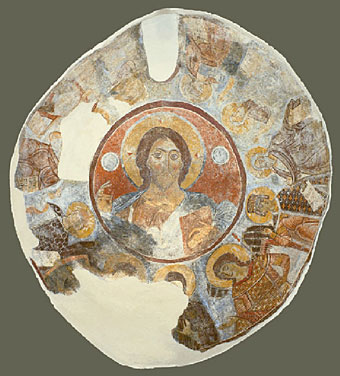
Dome featuring Christ Pantokrator, prophets, angels and Theotokos (1233\1234), Northern chapel of Hagios Nikolaos in Penteli Cave, 1,35m. height, 2,30m. diameter
 |
 |
 |
 |
Dome, Penteli Cave
Area: Byzantine and Christian Museum, Athens
Date: 1233/1234
Description:
Christos Pantokrator on a medal with red background dominates the top of the dome. Christ blesses with his right hand and holds a closed code in his left. He has big clear-cut characteristics, an austere and rough expression, big eyes with an intense and frowned look, and a stout body. He wears a red chiton and a dark blue pleated himation. Iconographically there is a repetition of the type established in the valuable mosaics of Hosios Loukas and the Daphni monastery, both dated to the 11th century. On the top of his head hover on discs the well-known letters ÉC XC.Below, on the drum, eleven half-bodied figures are portrayed. At the same level with Christ, Panagia in a dark red maphorion raises her hands to her chest in a supplication position. Two archangels surround Theotokos facing towards her. On the left is Michael, almost ruined, and on the right Gabriel. The delegates of the heavenly powers with open wings hold a staff and wear imperial officials’ uniforms adorned with precious stones. They have youthful characteristics, rich hair falling freely on the shoulders, and ooze with nobility and grace. David and Solomon follow them. They both wear embroidered cloaks fastened with a buckle on the right shoulder. They hold open eilitaria, and are crowned. Solomon’s crown is distinctive of the Byzantine emperors. It is adorned with prependulia, that is hanging decorative elements on its sides. Six more prophets are depicted behind them, all of them in quite lively positions and with intense gestures. They wear a cloak and a himation, and hold eilitaria, reminding us of ancient philosophers. From left to right, we see Solomon, Isaias, Iezekil, Abbakoum, Ionas, Daniel and Ilias. This synthesis is characterized by an exquisite artistic quality. It has a vivid dogmatic content that refers to the mystery of the Holy Incarnation. This is evident not only from the portrayal of Theotokos but also from the choice of the prophets and the quotations on their eilitaria. The wall paintings of the northern chapel in Penteli Cave share some common characteristics. These are the big wide open eyes of the figures, the decorative mood – mostly evident in the garments and the jewellery, the strong outlines and the flat attribution of the volumes. This exact style refers to a local workshop active in the broader area of Attica during the 13th century.
Date: 1233/1234
Description:
Christos Pantokrator on a medal with red background dominates the top of the dome. Christ blesses with his right hand and holds a closed code in his left. He has big clear-cut characteristics, an austere and rough expression, big eyes with an intense and frowned look, and a stout body. He wears a red chiton and a dark blue pleated himation. Iconographically there is a repetition of the type established in the valuable mosaics of Hosios Loukas and the Daphni monastery, both dated to the 11th century. On the top of his head hover on discs the well-known letters ÉC XC.Below, on the drum, eleven half-bodied figures are portrayed. At the same level with Christ, Panagia in a dark red maphorion raises her hands to her chest in a supplication position. Two archangels surround Theotokos facing towards her. On the left is Michael, almost ruined, and on the right Gabriel. The delegates of the heavenly powers with open wings hold a staff and wear imperial officials’ uniforms adorned with precious stones. They have youthful characteristics, rich hair falling freely on the shoulders, and ooze with nobility and grace. David and Solomon follow them. They both wear embroidered cloaks fastened with a buckle on the right shoulder. They hold open eilitaria, and are crowned. Solomon’s crown is distinctive of the Byzantine emperors. It is adorned with prependulia, that is hanging decorative elements on its sides. Six more prophets are depicted behind them, all of them in quite lively positions and with intense gestures. They wear a cloak and a himation, and hold eilitaria, reminding us of ancient philosophers. From left to right, we see Solomon, Isaias, Iezekil, Abbakoum, Ionas, Daniel and Ilias. This synthesis is characterized by an exquisite artistic quality. It has a vivid dogmatic content that refers to the mystery of the Holy Incarnation. This is evident not only from the portrayal of Theotokos but also from the choice of the prophets and the quotations on their eilitaria. The wall paintings of the northern chapel in Penteli Cave share some common characteristics. These are the big wide open eyes of the figures, the decorative mood – mostly evident in the garments and the jewellery, the strong outlines and the flat attribution of the volumes. This exact style refers to a local workshop active in the broader area of Attica during the 13th century.




